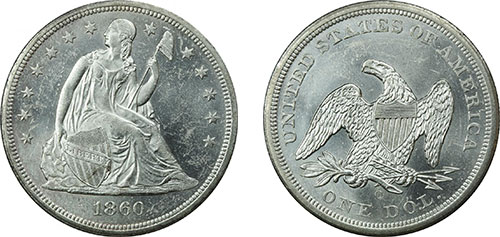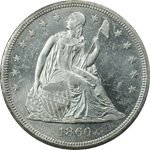The United States Mint produced Seated Liberty dollars from 1840 to 1873. The Seated Liberty was the last dollar silver coin to be struck until the Coinage Act of 1873, which temporarily halted production of silver dollars for American commerce. Designed by the U.S. Mint’s Chief Engraver, Christian Gobrecht, the obverse was based upon an earlier design used for the first silver dollar to be struck by the U.S. Mint, the “Gobrecht dollar”, which was produced between 1836 and 1839.
Whereas the Mint Act of 1792 made gold and silver legal tender (as in, specified weights of each equaled a dollar), the U.S. Mint only struck gold and silver coins when depositors supplied the precious metal. Yet, the fluctuation of market prices resulted in the overvaluation of either metal in terms of the other, which led to hoarding and melting, particularly of silver coins. In 1806, President Thomas Jefferson ordered all silver dollar mintage to be stopped to prevent the coins from being brought abroad for melting. While the ban was lifted in 1831, silver dollars were not minted until 1836. During these years, the Philadelphia Mint underwent various modernizations, and additional branch mints were authorized. In 1935, Mint Director Robert M. Patterson suggested to create an obverse design with Lady Liberty sitting on a boulder, holding a liberty pole and wearing Roman-style headgear (pileus), and a reverse design showing a flying eagle amidst 24 stars. After some modifications, the first Gobrecht dollars were minted in December of 1836. The Gobrecht dollar was eventually replaced by the Seated Liberty dollar four years later.

The obverse side of the Seated Liberty dollar features Lady Liberty sitting upon a rock, dressed in flowing robes. She holds a pole with a cap on the top in her left hand, while her right hand rests upon the tip of a shield that says LIBERTY. Thirteen stars circle the design, which represent the original colonies. This design is shared by various half-dimes, dimes, 20-cent pieces, quarters, and half dollars minted between 1836 and 1891; thus, many coin collectors seek to acquire all Seated Liberty coins. The reverse design shows a heraldic eagle, based on a design by late Mint Chief Engraver engraver that was used in the early part of the 19th century. The eagle holds arrows in one talon and an olive branch in the other one. Some people also refer to the Gobrecht dollar as a type of Seated Liberty dollar due the same obverse design. However, the Gobrecht dollar depicts a flying eagle on the reverse while only one clenched talon is visible.
The Seated Liberty coin displays a mintmark for New Orleans (O), San Francisco (S) or Carson City (CC) is located at the bottom of the design below the eagle’s talons. Coins minted at the Philadelphia Mint carry no mintmarks. For the first five years, Seated Liberty dollars were only struck by the Philadelphia Mint. By 1846, the New Orleans Mint also began production.
Towards the end of the 1840s, the California Gold Rush increased the supply of gold and thus also increased the price of silver. In response to rising prices, the U.S. Mint reduced the amount of silver in some silver coins, but they did not decrease the amount of silver in silver dollars. This encouraged people to melt down silver dollars, which might account for their scarcity today. In 1853, the value of the silver in the Seated Liberty dollar coin became worth more than the face value of the coin, which resulted in the coin being taken out of general circulation for a while. However, the coin was still being used as trade coin overseas. The dollar returned to general circulation when the silver price dropped again in 1870. Incidentally, one of the most rare issues of the first year’s return to circulation has a San Francisco (S) mint mark. Only a handful of 1870-S coins were struck.
The Seated Liberty dollar is comprised of 90 % silver and 10 %t copper.
Seated Liberty Dollar Facts
| Weight: | 26.73 g |
| Net fine weight: | 0.77344 ozt |
| Coin diameter: | 38.1 mm |
| Face value: | $1 |
The Seated Liberty coin comes in two major varieties, “No Motto” and “With Motto.” Coins were struck without a motto from 1840 to 1866. Only two issues from 1866 are known to exist. From 1866 to 1873, the reverse design was altered by adding a banner above the eagle that reads “IN GOD WE TRUST”. After the outbreak of the Civil War, people like Reverend M.R. Watkinson wanted to include a religious motto on American coinage, reflecting the growing religiosity of the American people during those years. The motto “In God We trust” was first used on the two-cent piece in 1864, and was placed on any coin produced by the U.S. Mint a year later. However, the Civil War years also brought about a coin shortage due to the large war debt incurred by the federal government, which resulted in high premiums on silver coins. The Mint continued to strike silver coins in limited numbers to be store in vaults.
Yet, when large quantities of silver were discovered in the American West in 1859, Director of the Mint Henry Linderman called for an end to striking silver dollars, as he speculated that increased silver mining in the West (especially upon completion of the transcontinental railroad) would amplify the supply of silver and cause its price to drop. This would render the value of the precious metal content in the silver dollar less than $1 and have silver suppliers deposit their product at the Mint to turn into dollars, which in turn would inflate the currency and drive gold out of commerce (Gresham’s Law). Eventually, the production of the Seated Liberty silver dollar was ended by the Coinage Act of 1873.
While the Seated Liberty dollar has a face value of $1, its value is far higher due to its silver content and rarity. Seated Liberty dollar coins in very good or better condition fetch at least a few hundred dollars. In fact, the scarcity of many issues makes it unlikely that complete sets could be purchased on a tight budget. Especially rare issues can sell for enormous sums: An 1866 issue without the motto “IN GOD WE TRUST” (of which only two are known) sold in 2005 at an auction for $1,207,500, and an 1870 issue struck at the San Francisco Mint (of which mintage figures are unknown, as their striking was never recorded) sold at an auction in 2003 for $1,092,500. It is important to note that Seated Liberty coins cannot be added to an Individual Retirement Account, as their worth is based on their numismatic value rather than the value of their silver content. Still, these valuable and historically significant coins are coveted by collectors and investors alike, as they can yield quite a generous profit.

